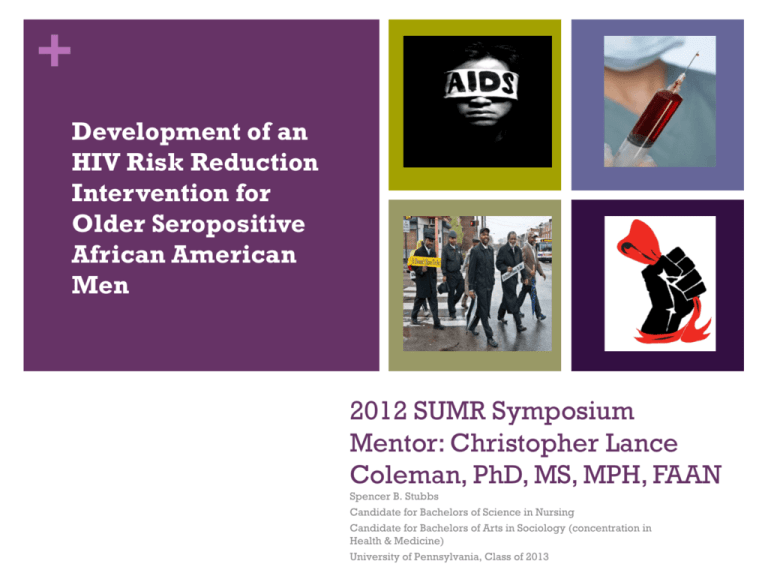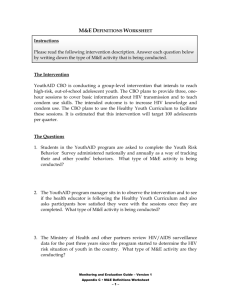
+
Development of an
HIV Risk Reduction
Intervention for
Older Seropositive
African American
Men
2012 SUMR Symposium
Mentor: Christopher Lance
Coleman, PhD, MS, MPH, FAAN
Spencer B. Stubbs
Candidate for Bachelors of Science in Nursing
Candidate for Bachelors of Arts in Sociology (concentration in
Health & Medicine)
University of Pennsylvania, Class of 2013
+
Agenda
Background
Overall Aim & Hypothesis
Research Methods & Study Findings
Conclusion
Q&A Session
+
Epidemiology of HIV in the
Geriatric Population
HIV is now a chronic disease
HIV in those who are fifty years and older comprise 27% of
all HIV cases in the United States
Of the 56,000 new cases of HIV infection, 45% were African
Americans (MSM Injection Drug Users Heterosexual)
African Americans are less likely than their white
counterparts to know their HIV status
“triple jeopardy” effect seen in older HIV+ population
+
Epidemiology of HIV in the
Geriatric Population (cont.)
Adults 50 years and older are more likely to…
Not use condoms during sexual encounters
Have more comorbid conditions known to complicate their HIV
treatments
Be less knowledgeable about HIV
Develop AIDS more rapidly
Experience greater marginalization compared w/ younger
populations
+
Epidemiology of HIV in the
Geriatric Population (cont.)
More specifically, older African American MSM are more
likely to…
Engage in unprotected receptive anal and vaginal intercourse
Report a history of marriage to women
Disclose being secretive about same sex behavior
Engage in bisexual relationships
Report not being “out” to their families
More likely to meet sexual partners through online services and
public parks than gay bars
+
Consistent Condom Use
Studies (Millett, et. al) have shown that African American
MSM engage in more high-risk sexual behavior, including a
failure to practice consistent condom use than did African
American heterosexual men
One study (Crawford, et. al) found that 20% of their sample of
HIV-positive MSM 50 years of age and older did not use
condoms with male partners and 72% reported engaging in
unprotected vaginal sex
37% reported being secretive about sexual behavior and having
multiple sex partners
+
Theoretical Framework
Intervention
Behavioral
Beliefs
Attitude
Normative
beliefs
Subjective
Norms
Control
Beliefs
Self-Efficacy
Intention
Condom
Use
+
Aim/Objective & Hypothesis
To tailor an intervention to teach safe sex strategies that can
be incorporated into the social context of the daily lives of
older HIV positive American American MSM
HIV Risk Reduction = condom adherence
+
Methods: Brief Overview of
Research Design
Design: Randomized control trial
Sample: 60 seropositive African American men fifty years
and older with a mean age of 52 years
Settings: Center for Health Equities Research (CHER)
Study: conducted in 4 phases: Phase I Phase IV
+
Phase Study Format
Phase
I
Focus
groups
Phase
II
Pilot test
on small
subset of
the
sample
Phase modificat
ion
III
Phase impleme
ntation
IV
+
Phase I
Series of focus groups conducted by the study team and staff at
ASOs and CBOs to gain insight about a proposed intervention,
recruitment, and retention strategies and data collection
instruments
Flyers and discrete sampling used to get this select group
Focus groups included: 8 seropositive AA MSM (mean age ~55)
and 8 members from ASOs and CBOs
Focus group participants were seen as consultants for the study
Intervention for review included 8 modules: risk assessment,
facts about HIV, facts about sexually transmitted diseases (STDs),
attitudes and vulnerability, learning to be safe, unsafe sex
triggers, condom negotiation and refusal skills, taking care of
your health
+
What the team learned from Phase
I…
Strong desire from the focus group to cover the following issues…
homophobia,
Social alienation
Ageism
Stigma and marginalization
Navigating sexual venues
Social networking
HIV disclosure
Increasing awareness of personal risk for HIV and STI
Risk assessment activities used to role-play condom negotiation skills when in
public areas
Acquiring resistant viral strains
Comorbidities
Viral load
Drug and alcohol use
Risks associated with rimming during anal/oral sex
+
Modified Intervention (four 2-hour
sessions)
Homophobia
Alienation
Marginalization
Ageism
Navigating through sexual venues safely in the face of alienation and isolation
Managing physical and psychosocial comorbid conditions that potentially trigger unsafe sex
Disclosing HIV status
Medication side effects
Viral load
Safe sex skills
+
Consistent with the Literature…
Insecurities w/ Age..
“we need to be around men our age when talking about risky
sexual behaviors”
“I’m not comfortable talking about having HIV or unprotected sex
with younger guys in the room”
“Many of us have lost so many friends, so the sessions should
provide an opportunity for us to talk about losses, and give us an
opportunity to make new friends.”
Showed Inconsistent Nature Condom Use…
“Some of our friends figure, at their age, what does it matter?”
“Why should we give up what little pleasure we have left?”
“We are already infected so we cannot get infected again”
+
Phase II
Study questionnaire pilot tested with 8 HIV+ AA MSM
(eligibility: age, seropositive status, having sex of any kind
with a man in the previous 3 months, being born male)
Reordering of sections (for ex: having childhood sexual
experiences placed before interpersonal conflict)
Use of common vernacular particularly when it comes to
assertive/submissive roles during intercourse
Suggested to use the audio computer-assisted self interview
(ACASI) because of the length of survey
+
Phase III
Combined feedback from both phase I and phase II in order to
tailor the intervention
Sessions modified to include:
Stigma
Alienation and marginalization
Side effect of drug therapy and the comorbidities associated with
aging and HIV (such as diabetes, heart disease, mental changes, HIV
symptoms, arthritis, etc)
Include visual aid when teaching safe sex practices and intimacy
(“cheeking video”)
Made to be more interactive in general
Include SWAT negotiation in order to increase condom negotiation
skills (say no to unsafe behavior, be prepared to say why you want
to be safe, provide alternative safe behaviors, and talk it out with
your partner.)
+
Phase IV – The “Actual”
Intervention
The modified intevention was pilot tested with 60 HIV+ AA
MSM 50 years of age and older
Men were randomized to either an HIV risk condition or a
health condition
Health condition = focused on content related to risks for
heart disease, hypertension, stroke, diabetes, and certain
cancers…which all also happen to be causes of morbidity
and mortality amongst african americans
HIV risk condition = focused on content related to sexual
health practice
+
Results: Flow of Study Participants
Assessed for Eligibility
(n = 82); Enrolled and
Randomized (n = 60);
Not meeting Inclusion
Criteria (n = 22)
HIV Risk Condition
(n=30); Received
allocated intervention
(n=30)
Allocation
Health Condition
(n=30); received
allocated health
condition (n=30)
Lost to follow-up (n = 0)
Follow-up
Lost to follow-up (n = 0)
Analyzed (n = 30)
Analysis
Analyzed (n = 30)
+ Results: Comparison of Baseline
Characteristics by Study Group
Characteristic
median
Entire Sample (n =
60)
HIV risk reduction
intervention (n =
30)
Health Control (n =
30)
P Value
Age, years
51 (50-72)
51.5 (50-59)
51 (50-72)
ns
Employed
6 (10.3)
3 (10.0)
3 (10.0)
ns
Education
High
School or
less
Some
College
Current living
situation
alone
w/ others
Relationship Status
Single/
divorced/
widowed
Married/
living/
together
Sexual Orientation
homosex.
bisex.
heterosex
ns
28 (47.5)
15 (50.0)
13 (44.8)
31 (52.5)
15 (50.0)
16 (55.2)
ns
25 (45.5)
30 (54.5)
14 (48.3)
15 (51.7)
11 (42.3)
15 (57.7)
ns
46 (82.1)
22 (78.6)
24 (85.7)
10 (17.9)
6 (21.4)
4 (14.3)
ns
43 (71.7)
12 (20.0)
5 (8.3)
21 (70.0)
8 (26.7)
1 (3.3)
22 (73.3)
4 (13.3)
4 (13.3)
+
Results (cont.)
Percentage of Participant Attending Data Collection Sessions by
Group and Time
Group
Baseline
Three Months
HIV risk reduction
condition
n = 30
100% (n = 30)
Health Condition
n = 30
100% (n = 30)
Percentage Reporting Consistent Condom Use in the Past Three
Months by Group and Time
Group
Baseline
Three Months
HIV risk reduction
condition
n = 40.9
71.4
Health Condition
n = 42.1
55.0
+
Study Findings
The groups did not differ significantly at baseline on demographic characteristics
Every participant attended sessions 1 and 2, 98% attended session 3, and 100% attended
session 4
Although the unadjusted analyses did not reach statistical significance, men in the HIV risk
condition were twice as likely to use condoms consistently [OR = 2.04; 95% CI = 0.48-8.77;
p=0.336]
50% of participants reported inconsistent condom use (15 men in the HIV risk condition and
15 in the health condition). Among these men, those in the HIV risk condition were 5 times
more likely to start using condoms consistently compared to those in the health condition [OR
= 5.18; 95% CI=0.97-27.78; P=0.054]
Participants in the health condition were 43% more likely to have had multiple sex partners
50% of the participants reported having multiple partners (15//15)
Men in the health condition were 2.5 times more likely to report having multiple sex partners
at the 3-month follow-up compared with the risk reduction intervention [OR=2.45, 95%
CI=0.46-13.16; P=0.296]
+
What I learned this summer…
How to write an R01 grant application
Statistics and multivariate/bivariate analyses
Critical Race Theory, Gender Queer Theory, Literature
Review
Patience is a virtue!
Communication and Multitasking (researchers balance a lot)
PhD is definitely the goal!
+
Special Thanks to Joanne Levy,
Lissy Madden, and the LDI Staff!
+
Questions?
Spencer Barrington Stubbs
Cell: 908-315-6242
Email: stubbss@nursing.upenn.edu





